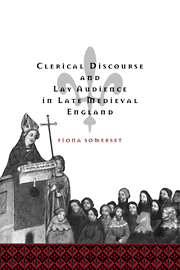Book contents
- Frontmatter
- Contents
- Acknowledgements
- PART I THE VERNACULAR OEUVRE
- PART II CONTESTING VERNACULAR PUBLICATION
- 4 Answering the Twelve Conclusions: Dymmok's halfhearted gestures toward publication
- 5 The Upland Series and the invention of invective, 1350–1410
- 6 Vernacular argumentation in The Testimony of William Thorpe
- Appendix
- Works cited
- Index
- CAMBRIDGE STUDIES IN MEDIEVAL LITERATURE
4 - Answering the Twelve Conclusions: Dymmok's halfhearted gestures toward publication
Published online by Cambridge University Press: 04 December 2009
- Frontmatter
- Contents
- Acknowledgements
- PART I THE VERNACULAR OEUVRE
- PART II CONTESTING VERNACULAR PUBLICATION
- 4 Answering the Twelve Conclusions: Dymmok's halfhearted gestures toward publication
- 5 The Upland Series and the invention of invective, 1350–1410
- 6 Vernacular argumentation in The Testimony of William Thorpe
- Appendix
- Works cited
- Index
- CAMBRIDGE STUDIES IN MEDIEVAL LITERATURE
Summary
As is often the case with heretical materials, we know of the Twelve Conclusions only through the efforts to record and refute them made by their orthodox opponents. Although our main concern here will be with their most dogged and thorough opponent, Roger Dymmok, we should first gather what we can from the form of the Conclusions he has preserved for us.
Like the ‘Petition’ examined in Chapter one, the Conclusions aim for the most important and influential audience in the land; the audience anyone wanting redress might want to achieve: ‘þe lordis and þe comunys of þe parlement’ (24/2). The Conclusions are broadly critical of church institutions, rituals, and rules, and in particular of ‘prelacye’ (the church hierarchy) and ‘priuat religion’ (orders of monks, canons, and friars). Their twelve points purport to aim at the ‘reformaciun’ of current institutions back toward the state of the primitive church, and the basis for their address to Parliament is that current ecclesiastical institutions do various kinds of harm to the people that it ought to be Parliament's responsibility to redress. However, like the ‘Petition’ in Chapter one, this petition does not use the official channels with which it associates itself. Although it apes the mode of address and presentation of a parliamentary petition, it is a hybrid product: it claims the virtues of poverty and championship of the people, but leaves the precise associations of its writers extremely murky.
The writers of the Twelve Conclusions set themselves apart from the institutional clergy.
- Type
- Chapter
- Information
- Clerical Discourse and Lay Audience in Late Medieval England , pp. 103 - 134Publisher: Cambridge University PressPrint publication year: 1998



